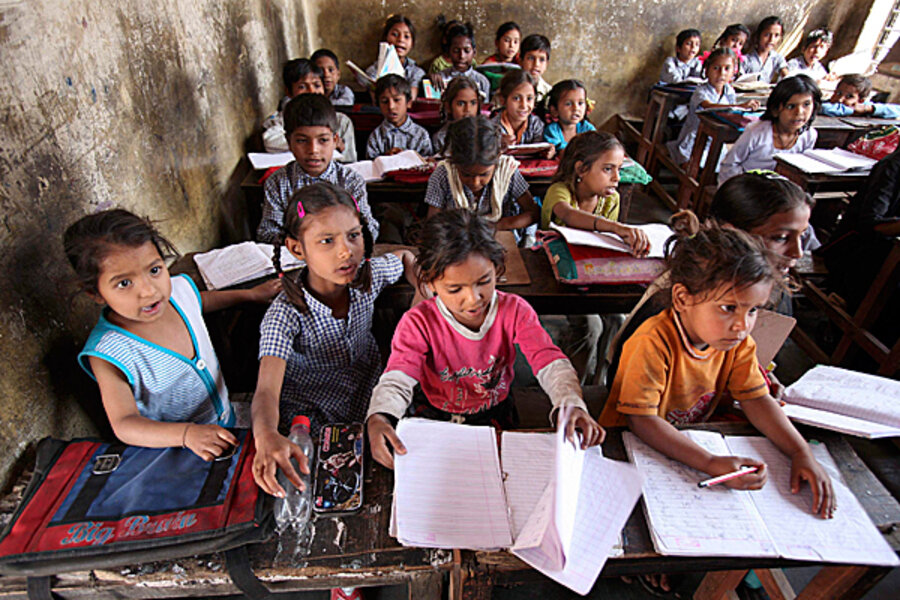India's 'education for all' mandate poses big test
Loading...
| New Delhi
“I go to school every day,” says Arshad Alam, a skinny, barefoot teenager, as he minds his four younger siblings one sunny Monday in the middle of the semester.
Five minutes later the boy is describing his real life: earning 50 rupees ($1.10) a day as a rag picker, sorting through garbage for recyclable pieces of plastic and metal.
With his father in prison, his road-builder stepfather earning 100 rupees a day, and his mother dependent on handouts of rice and wheat flour from a local church to feed her family, Alam’s earnings are worth more than “that ABCD,” he says, with a disdainful shrug.
Last week, India enacted a historic law designed to get children like Alam into school. The Right of Children to Free and Compulsory Education Act, which was passed in parliament in 2009, gives all children aged between 6 and 14 years of age a legal right to a free education.
While the law has won praise, critics question whether the government can overcome its chronic underinvestment in education to meet the ambitious goal.
At the moment, India falls woefully short of the new provisions. Ten million children of primary school age are not enrolled in school, according to the education ministry.
‘A’ for intentions
The new law is part of raft of rights-based legislation introduced by India’s current government, a coalition led by the Congress Party, to improve poor Indians’ access to public services. The Right to Education Act follows a right-to-information law and a public works scheme, enshrined in law, which guarantees 100 days of work to every rural household in the country. A right-to-food law may follow.
The education law makes it the obligation of government to pay for all children to attend school. State-run schools will be upgraded, and private schools forced to reserve one quarter of their places for children from impoverished backgrounds. The law stipulates that primary schools should have one teacher for every 30 pupils, compared to a current average of one teacher per 50 children.
The legislation also makes it illegal to deny admission to children who lack documents like birth certificates, a common impediment for the poor to access services. In all, the law is expected to cost India’s central and state governments more than $35 billion over the next five years.
“This demonstrates our national commitment to the education of our children and to the future of India,” Prime Minister Manmohan Singh said in a televised address last week.
He added that he was, “born to a family of modest means. In my childhood I had to walk a long distance to go to school. I read under the dim light of a kerosene lamp. I am what I am today because of education.”
Education is one of the biggest challenges facing India, where 51 percent of the population is under 25 years of age. India’s “youth bulge” could turn into a demographic disaster if the government fails in it.
So the law has been welcomed by nongovernmental organizations, including UNICEF. “RTE will propel India to even greater heights of prosperity and productivity for all guaranteeing children their right to a quality education and a brighter future,” said Karin Hulshof, UNICEF Representative in India, in a statement.
Real test: how to implement
But louder than the cheers for this historic law are questions about how it will be implemented in India, a nation of 1.2 billion people, in which money and resources intended for public services often go astray.
Critics of the law have been quick to point out that a 2004 law banning child labor is routinely flouted in India.
This not only raises questions about how the Right to Education Act will be implemented when other laws have not been; it also raises questions about the government figure of 10 million children out of school.
Save the Children, an NGO, says that there are an estimated 40 million children in India who are engaged in underage labor. Ramakant Rai, country head for the National Coalition for Education, a Delhi-based NGO, says that the last national census, in 2001, showed that 85 million CHILDREN had either never attended school or had dropped out.
He, like other critics, questions whether the law will do enough to compensate for decades of underinvestment in education, which accounts for 11 percent of government spending in India, compared with 16 percent in China.
Government-run schools in India are famously run-down and short on basic equipment and teachers, who are notoriously absent themselves.
Absent teachers, schools in slums
Indeed, so shoddy are government-run schools that about 50 percent of parents in urban areas choose to send their children to private schools, where students have a 41 percent reading advantage in English over their public-school peers, according to the 2009 Annual Status of Education Report.
“I would not send my daughter to a government school,” says Kumrunissa, a housewife who goes by one name, as she walks her son Chan Banu to school. That school costs only 300 rupees ($6.60) a month, and it is located in a slum. “But it is much better than any government school – everybody says so,” says Kumrunissa.
Prestigious private schools have resisted the law’s requirement that it reserve a quarter of spots for children from disadvantaged backgrounds.
But the law also requires that all private schools win official government recognition within three years or be closed down. While private schools for the rich would have no difficulty meeting the standards required, the cheaper private schools may find it difficult.
Kumrunissa is not worried, though. “I’ve never heard of a Right to Education Act,” she says.





